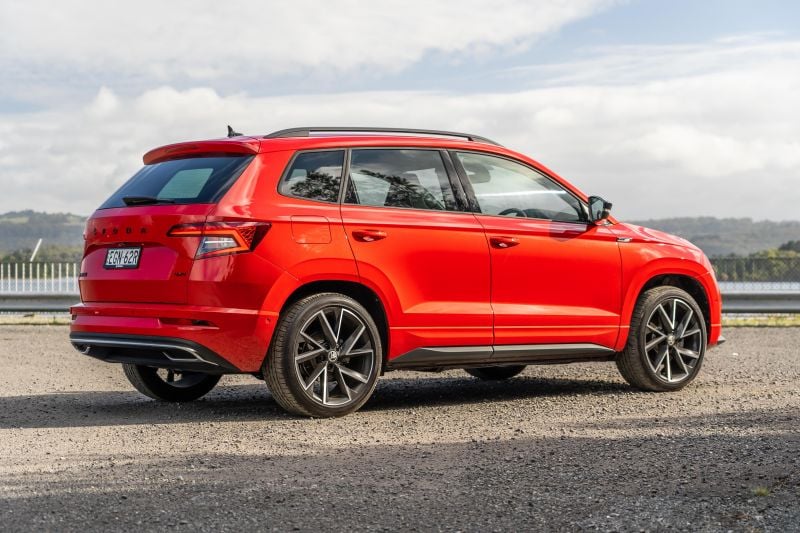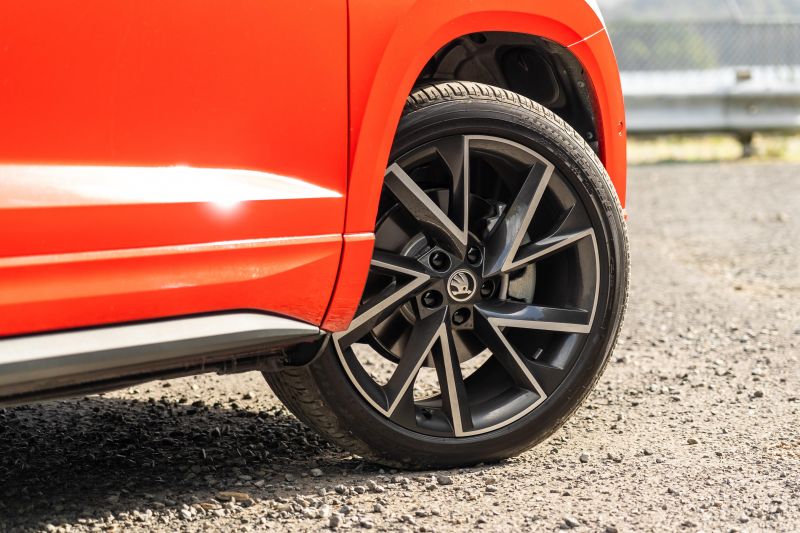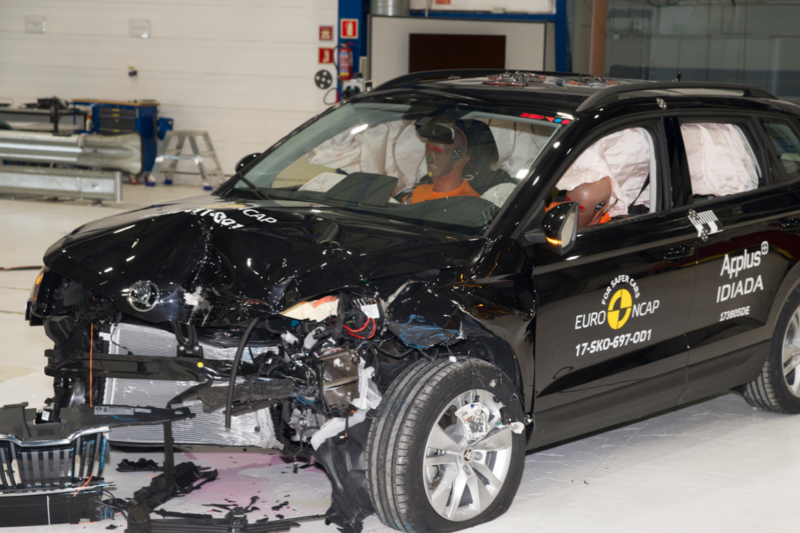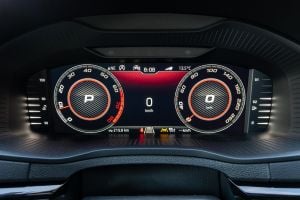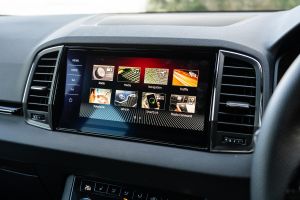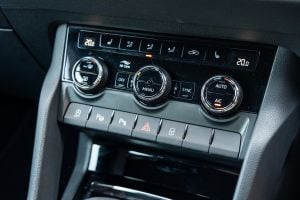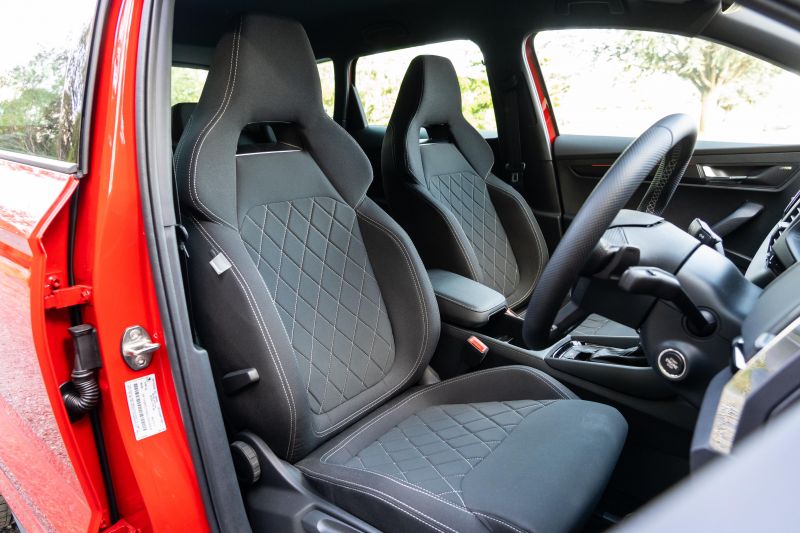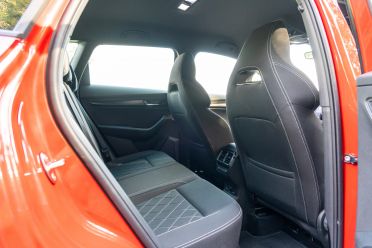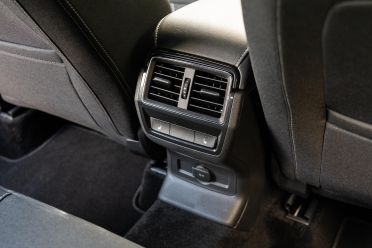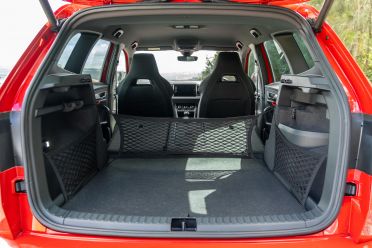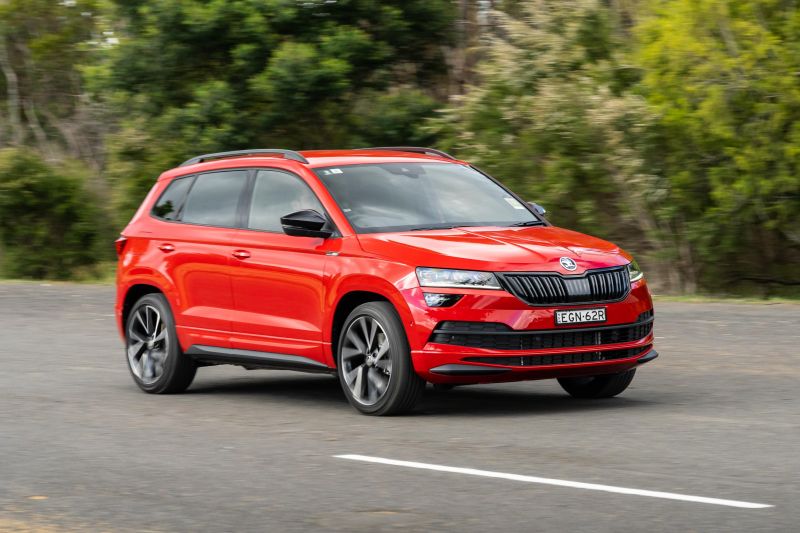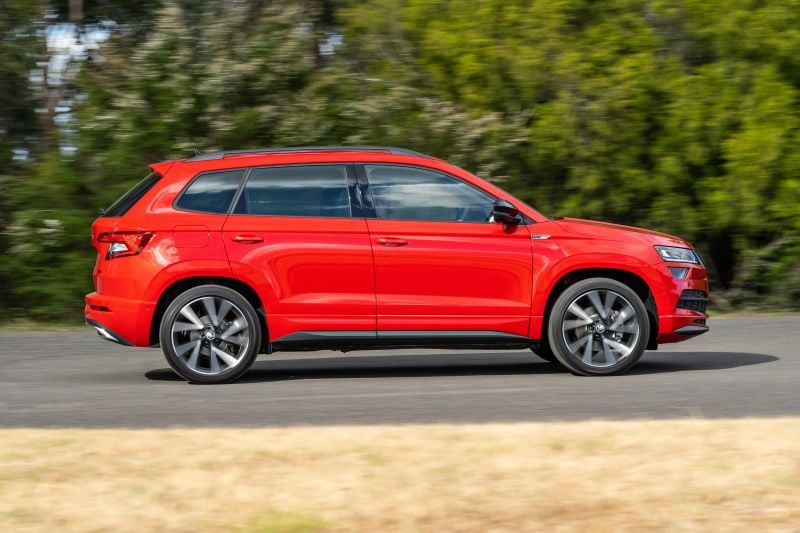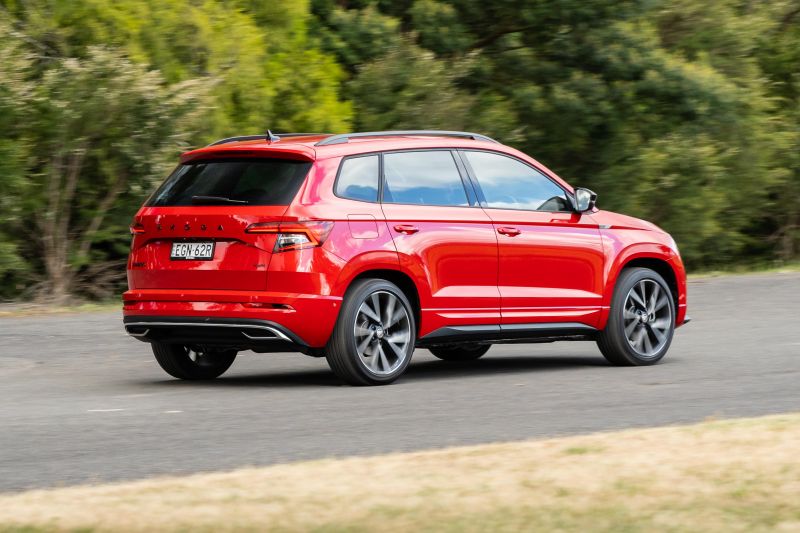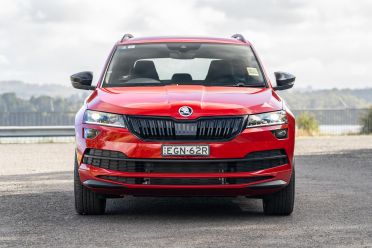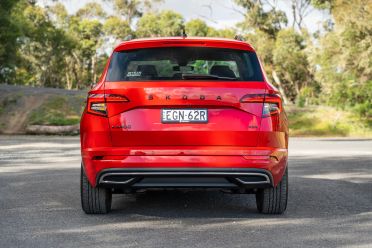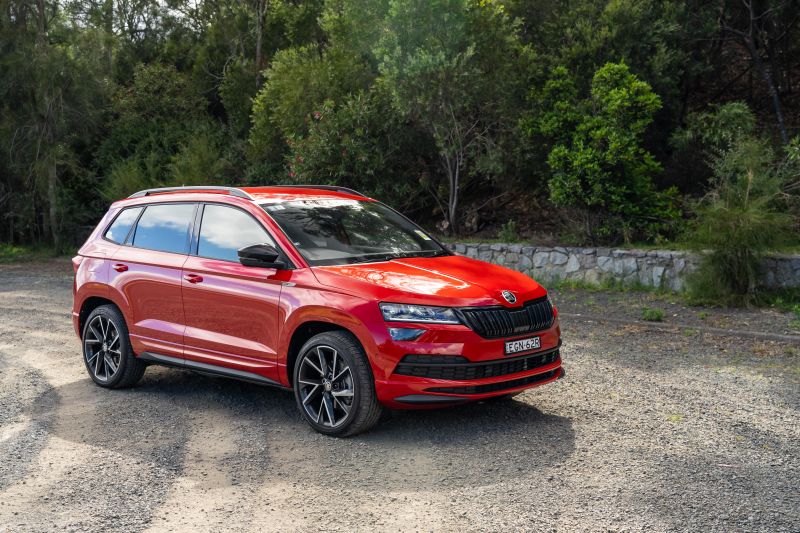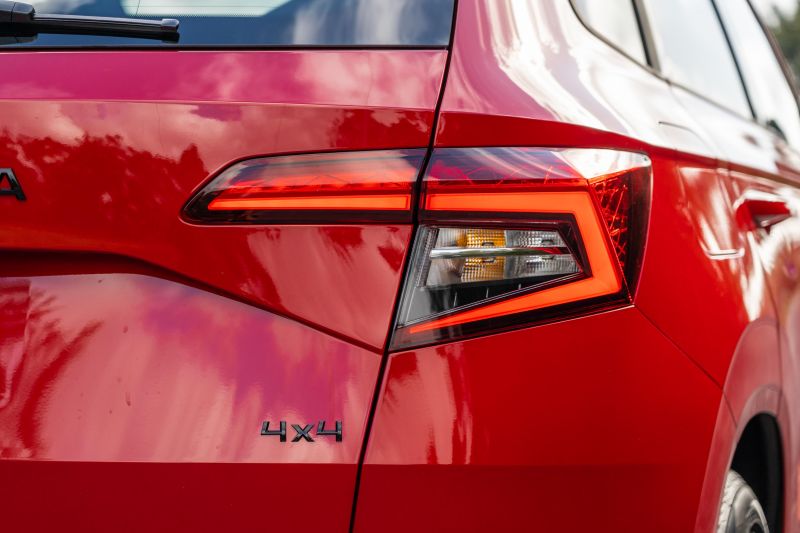The Skoda Karoq’s market share in Australia’s Medium SUV segment this year sits at a rather modest 0.8 per cent, with only 1140 people taking the plunge and buying one.
Comparatively few people have Skoda on their final shopping lists, compared to parent company Volkswagen.
The Karoq is the middle child of the Czech brand’s SUV range, sitting above the Kamiq and beneath the Kodiaq. It also seems to be one of the industry’s best-kept secrets.

How much does the Skoda Karoq 140TSI Sportline cost?
The entry point to Skoda’s rejigged 2021 Karoq range is the $32,990 (list price) or $36,990 (drive-away) front-wheel drive (FWD) model powered by a 1.4-litre turbocharged petrol engine.
But here we are driving the flagship offering, called Karoq 140TSI Sportline. It uses a 2.0-litre engine with appreciably more power and torque, and an all-wheel drive (AWD) system. It’s priced at $39,990 (list) or $43,990 (drive-away).
To give this some context, a mid-level Volkswagen Tiguan 132TSI AWD costs $46,990 drive-away, a Mazda CX-5 Touring AWD $43,790 drive-away, and a Ford Escape ST-Line AWD is a sharp $41,990 drive-away.
True, the Karoq is a bit shorter dimensionally than these three, but good packaging means it stacks up well against them anyway. Its circa 4.4-metre length puts it at the lower end of the ‘Medium SUV’ class or upper end of the ‘Small SUV’ class, if such arbitrary segmentation is of use to you.
What do you get?
The Karoq 140TSI Sportline comes standard with privacy glass, adaptive LED headlights, rain-sensing wipers, 19-inch ‘Vega’ alloy wheels, black side mirrors and roof rails, projecting puddle lamps, and a hands-free proximity key fob that unlocks the car for you.
Inside there’s a digitised ‘virtual cockpit’ instrument cluster, LED ambient cabin lighting, fabric seats with a one-piece backrest and amble bolstering, dual-zone climate control, an auto-dimming rear-view mirror, and an 8.0-inch touchscreen with Apple CarPlay and Android Auto.
That’s all good, but there are a few options packs there to tempt you.
There’s the $4100 Tech Pack with a 9.2-inch glass touchscreen with hand-gesture recognition, satellite-navigation, a 10-speaker ‘Canton’ sound system upgrade, DAB+, a wireless phone charger, automated park assist, three programmable smart keys, and a powered tailgate.
Then there’s the $2600 Travel Pack which adds auto-folding mirrors, front and rear heated seats, lane assist, blind-spot monitoring (called Side Assist), traffic jam assist, Emergency Assist, rear cross-traffic alert, and Adaptive Chassis Control (electronically controlled damping).
With these packs fitted plus the $1100 paint, our test car went from a $39,990 RRP to $47,790 plus on-roads, equal to around $52,000 on the road, roughly the same as a flagship Mazda CX-5 Akera. Which does change the value equation just a touch.
Is the Skoda Karoq 140TSI Sportline safe?
Standard safety features include seven airbags, ISOFIX and top-tether points, a driver fatigue monitor, and two nifty systems called Multi-collision Brake and Manoeuvre Braking Assist.
The former stops you from rolling forward after a rear impact, the latter mates automatic rear braking to the parking sensor system.
You also get forward autonomous emergency braking, and adaptive cruise control. The extra safety features available were mentioned earlier, in the breakdown of the Travel Package. I’d urge Skoda to make these features standard for the 2021 update.
Crash tester ANCAP awarded the Karoq five stars with a 2017 date stamp. It achieved 93 per cent for adult occupant protection, 79 per cent for child occupant protection, 73 per cent for pedestrian protection, and 58 per cent for safety assist features.
What is the Skoda Karoq 140TSI Sportline like on the inside?
First off, the single-piece-backrest driver’s ‘Thermoflux’ seat is just great, with plenty of side and thigh support, and handsome diamond-pattern stitching. I also like Skoda putting the start button where the ignition barrel used to go – it’s just intuitive, and not common.
There’s plenty of seat and wheel adjustment, and the standard digital instrument cluster looks great and loads quickly. You can display simple dials that change colour and shape depending on your driving mode, or you can display full-width maps as the picture further up the story shows.
Our test car had the optional 9.2-inch touchscreen with slick animated pictures for each sub menu. Skoda has reskinned the software to stand apart from parent Volkswagen. The screen lets you swipe like a smartphone, and loads quickly.
Sat-nav comes standard with this option, but all models get Apple CarPlay and Android Auto for phone mirroring, and for streaming the also-optional DAB+ audio, if you don’t want to pay for the package.
The climate control system uses knurled dials and damped buttons for ease-of-use, and the switches below are clear and intuitive.
Everything is really nicely put together, with no rogue panel gaps, and the tactility of all touch points is suitably premium. I just wish Skoda, among numerous equally culpable manufacturers, would ease off the shiny black trim everywhere, because within 30 minutes it’s covered in dust and smudges and reflecting sun glare.
True to Skoda form, there are some cool touches that add a layer of thoughtfulness. The glovebox is backlit and ventilated, there’s a small waste bin in the door pocket, a plastic ticket-holding clip on the A-pillar, a capacious centre console, and a sunglasses holder in the roof. Those centre-tunnel cupholders are pretty shallow though.
The 4382mm long Karoq is quite short by class standards (170mm shorter than a Mazda CX-5) but well packaged. Even taller occupants like me at 194cm should expect useable legroom and headroom. Back-seat features include grab handles, coat hooks, air vents, a 12V socket, and heated outboard seat bases (with the option pack).
However, the fitment of bulky AWD means the base FWD Karoq 110TSI’s ingenious back seats are not fitted. These seats, like the old Skoda Yeti’s, slide on rails, tumble forwards, and can even be removed altogether. The Sportline 140’s seatbacks do fold downwards 40:20:40 still, though.
At 521 litres, expanding to 1630L with the seats folded, the Karoq’s nicely carpeted boot is massive for its dimensional footprint. There are also nifty touches like a removable torch, separated cubbies behind the wheel arches, numerous heavy-duty bag hooks, cargo netting, and levers to flip-fold the back seats from the boot area.
Premium unleaded only
The engine in the Skoda Karoq Sportline is among the first in Australia with a petrol particulate filter.
What’s under the bonnet?
The 2.0-litre turbocharged petrol engine – versions of this unit are also found in cars like the Volkswagen T-Roc and Audi Q2 – makes 140kW of power at 6000rpm and 320Nm of torque from just 1500rpm out to 4100rpm.
It’s the second Skoda model in Australia to get a Euro-market-friendly petrol particulate filter (PPF) to burn off harmful particulates emitted, so 95 RON premium fuel is absolutely essential.
It’s mated to a seven-speed DSG dual-clutch automatic with paddles, sending torque to the road via an on-demand AWD system with variable torque split. There are also various driving modes (Sport, Normal etc.) that adjust the throttle calibration and gearing.
Combined-cycle fuel consumption was 6.9 litres per 100km during bench testing (I averaged mid 8s), and the zero to 100km/h dash can be dispatched in a snappy 7.3 seconds (we timed it at 7.52 seconds). It’s also rated to tow 1900kg if you’ve trailer-braking.
How does the Skoda Karoq 140TSI Sportline drive?
It’s a cracking little engine, which bolts the 1550kg (tare mass) Karoq to 100km/h in a time that would’ve matched last generation’s hot hatches.
There’s ample torque or pulling power just off idle point which helps rolling response, and the DSG is very well calibrated, showing little of the low-speed fussiness or jerkiness inherent to some dual-clutch units.
This is helped by the fitment of Auto Hold which stops the car creeping in D, with the brakes off.
There’s also a sound enhancer device that amplifies the engine note when you tip over into Sports mode, and rather than sounding naff it actually pipes a pleasant growliness into the cabin under heavy acceleration. This Karoq is called ‘Sportline’, and it lives up to the badge’s promise.
Ditto for the body control and handling, which is flatter and more tied-down than many SUVs, and the direct steering that has changeable resistance levels contingent on the style of driving you want to do.
The ride quality is firm, but never brittle or jittery over sharp hits and corrugations despite the low-profile tyres. The damping offers enough control to retain an agile feel, but there are degrees of decoupling from surface changes too.
We did notice some tyre roar over coarser chip roads, which interrupted the interior ambience. It’s not terrible, but there are times where its refinement levels could be better.
In terms of off-roading, it’d be best to stick to light duties. You have a decent but hardly super-high-riding 164mm of clearance, but it’s reassuring to know you can rely on all-paw traction on snow, mud, or even wet grass.
Once those front wheels slip, it’s showtime for the car’s electronic brain to order the AWD system’s multi-plate clutch, to engage the rear wheels. An off-road-focused drive mode changes the drivetrain and stability control parameters to suit slippery surfaces.
How much does the Skoda Karoq 140TSI Sportline cost to run?
Skoda Australia gives you a five-year and unlimited-kilometre warranty. You get a year of free roadside assistance with that, which is extended each time you return the car to an official dealer for servicing.
In terms of maintenance, the smart money is put into a pre-paid Service Pack, which covers the first five services (each visit at a 12 months or 15,000km intervals) for $1400.
Skoda offers such a plan to entice you to keep your car serviced at one of its dealers rather than an independent repairer. If you elect to pay-as-you-go, the first five years/75,000km of servicing will instead cost you a steep $2527.
CarExpert’s Take on the Skoda Karoq 140TSI Sportline
Once you add some choice option packs, as fitted to our test car, that $44,000 drive-away bargain price point is altered somewhat, to north of $50,000 – which changes the equation a tad.
But the Karoq Sportline is really what Skoda’s middle-child SUV should’ve been all along, had factory supply been sufficient from day one.
It has the brand’s signature outsider charm mixed with a premium European feel, a ripping little drivetrain, handsome design, plenty of space inside given the small footprint, and reasonable running costs through an admittedly small dealer network.
It’s the sort of mid-sized SUV that requires a little outside the box thinking, but I’d happily recommend you take the plunge.
For more, don’t forget to check out our video, embedded above.
Click on the images for the full gallery
MORE: Skoda Karoq news and reviews
MORE: Skoda news and reviews






